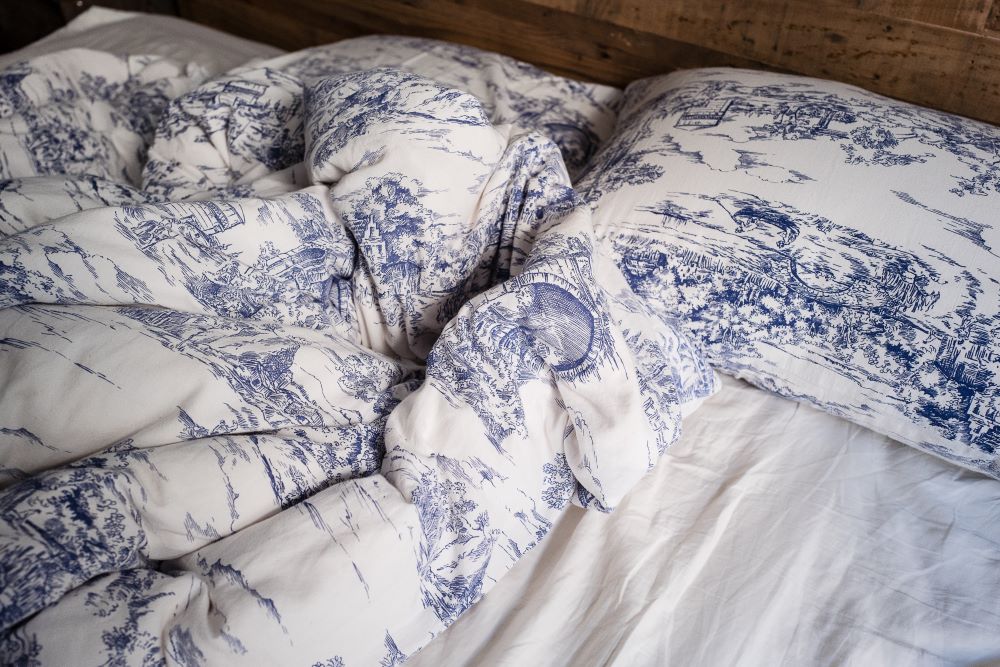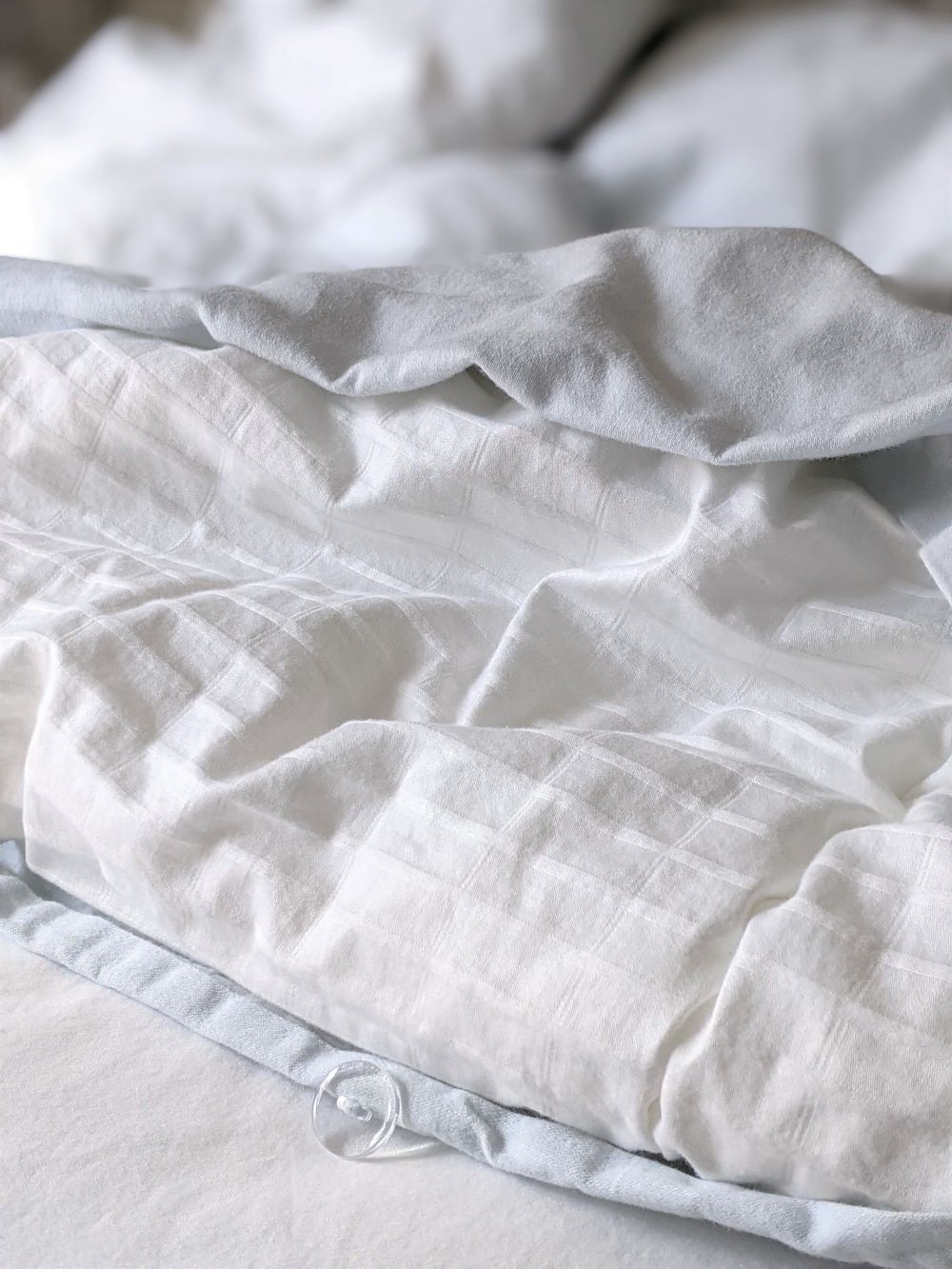Washing your duvet or down comforter might seem like a daunting task, but it’s a lot simpler than you’d think (just a touch time consuming). Follow these simple steps and tips for how to clean a duvet and down comforter at home (and prepare for the dreamiest sleep of your life!).

How to Wash a Duvet or Down Comforter
Washing a duvet or down comforter isn’t challenging per se, but there are a few key things to know before you begin. Good quality bedding can last a lifetime if properly cared for, so it’s worth it to take the time to wash your bedding correctly. Set aside a full day at home (the drying process can take hours, and requires regular monitoring), and prep for the task with all of the necessary equipment and products: a front-load washer and dryer, a gentle fragrance-free detergent, stain remover, two washer safer dryer balls (you can make DIY versions with tennis balls in socks, tied with a knot), and dryer sheets.
Read more: All About Laundry Stripping, the Latest Cleaning Trend

The Importance of a Front-Load Washer and Dryer
Washing a down comforter and duvet properly comes down to an even washing and drying. You want to avoid the duvet getting twisted, filling piling, and moisture getting trapped during the drying process. A large-capacity washer and dryer are ideal for this job. If you’re worried your machines are too small, look into laundromats nearby that often have large-capacity drums. Front load washers and dryers are also best for keeping contents tumbling throughout the cycle (they don’t have center agitators which items can get easily tangled around).
Read more: 12 Things You Can and Can’t Wash in the Washing Machine

Step One: Loading a Duvet Into a Washing Machine
When loading a duvet or down comforter into a washing machine, do your best to avoid folding or twisting it. Aim to keep it as evenly spread out as possible. Add washer-safe dryer balls will help to avoid this. You can make an easy DIY version by slipping a tennis ball into a sock, and knotting it close. Toss two of these in the washing machine and they’ll help to avoid clumping and fluff up the down filling!
Read more: 10 Minimalist Bedroom Decorating Ideas That Aren’t Boring

Washing Your Duvet at Home
Never add soap directly into the drum, as it can collect in the down filling. Use a mild laundry detergent, added to the soap drawer, and select a gentle, delicate cycle with warm water. If possible, add an extra rinse cycle. When the cycle is finished, check the duvet for soap residue. If you think there’s any chance of lingering soap, put the duvet back in for a second rinse cycle without soap.
Once the duvet is thoroughly rinsed, carefully transfer it to your dryer. Wet down is very heavy, and a bit smelly, but have no fear, after drying, the odor will be gone.

Drying a Duvet or Down Comforter
After carefully placing the duvet or down comforter into the dryer, add your dryer balls. Select the lowest heat setting possible, and let it run for 30 minutes. Down can scorch easily so it’s important not to overheat the comforter. At the same time, if down isn’t completely dry, you’ll risk mildew.
In 30 minute increments, continue to run the dryer and check the duvet between each session. Do your best to spread out the duvet when you check it, and unwrap any twists that develop. You’re aiming for an even drying process.

Drying a Down Comforter and Duvet
Don’t be surprised if the drying process for your down comforter and duvet takes hours. It’s better to extend the drying time to ensure there’s zero moisture left. If you’re lucky enough to have a warm, sunny day and a clothesline, you can hang your bedding outside too and let the sun work wonders. Sunlight does double duty: it dried bedding and helps keep whites bright!

Duvet Care: How to Store a Duvet or Down Comforter
Now that you know how to properly wash and dry your down comforter, there are a few more tips to keep in mind to ensure you get the most out of it. If you swap your down comforter in and out seasonally, make sure to always clean and dry it thoroughly before storing it away. Store your down comforter in a clean, cotton bag.

How to Repair a Down Comforter
Don’t fret over a rip in your down comforter. Iron-on patches are great for preventing small tears from growing bigger. You can also sew any larger holes that appear, but you’ll risk a misshapen comforter.

Treating Stains on Duvets
If you spot a stain on your duvet or down comforter, treat it as quickly as possible. Do your best to spread away the down filling so you’re only treating the fabric cover. Wet the area with warm water, apply a stain remover and then dab it gently to help lift the stain. Let it dry fully before fluffing up the filling!
Read more: How to Get Rid of Bedroom Clutter Once and For All

When to Wash Your Duvet or Down Comforter
If your duvet has a cover that you can remove and wash, you don’t actually need to wash it that often. Once a year is fine! That being said, washing your duvet or down comforter won’t damage or wear it out, so there’s no harm in doing it more frequently. Just ensure you’re following the proper steps and allowing it to dry fully after washing.
Related: Super Easy Ways to Add Character (and Value) to Your Bedroom
HGTV your inbox.
By clicking "SIGN UP” you agree to receive emails from HGTV and accept Corus' Terms of Use and Corus' Privacy Policy.




